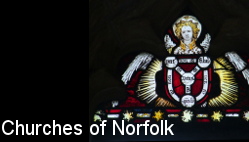
home I index I latest I glossary I introductions I e-mail I about this site
St Edmund, Emneth
Follow these journeys as they happen at Last Of England Twitter.
| St
Edmund, Emneth As you head westwards towards the edge of Norfolk you enter what is perhaps the strangest part of this big county. The dykes, drifts and flatlands seem to have spilled over the border from Cambridgeshire a couple of miles off. This is Norfolk's small part of the Fen Country. There is barely a tree in sight, nothing but long straight roads that occasionally and abruptly veer off to cross a ditch or a dyke. Occasional houses are austere, understated, their little gardens shocks of green, jarring in the vastness. Everything is visible here. There is no play of light, no subtlety of colour. No dark secret could be contained for ever by this land. I thought of what Seamus Heaney wrote about the old man-killing parishes of Jutland, although in truth this was a landscape I recognised, for it is so like the Isle of Ely where I was born. You have left the Diocese of
Norwich far behind, and have entered the Diocese of Ely.
The lane joins a wider road through Emneth Hungate, where
the recluse Tony Martin shot a burglar dead in 1999, and
then before you leave Norfolk altogether you enter the
surprise of of semis, bungalows and older houses. This is
Emneth, a Norfolk suburb of the Cambridgeshire town of
Wisbech. The old course of the River Nene, which forms
the border between Norfolk and Cambridgeshire here, runs
half a mile to the west. The road is busy, for it
connects Wisbech to Ely. At its widest point it curves to
reveal the large church and wide churchyard of the parish
church of Emneth. The village name appears to mean the
hythe or landing place of a man called Eana, and the -eth
placename ending occurs a number of times over the border
in Cambridgeshire. The oldest is against the south wall, set below the window splay. It is relatively simple, with original paintwork and inscriptions, but no figures. The one opposite is quite something else again. This is to the younger Sir Thomas,with him and his wife lying in clothes that are still late Elizabethan despite the date, under a canopy supported by marble pillars. Most memorable is the recumbent figure of their infant son, his head resting on a cushion that partly conceals a skull. The whole piece is the work of Nicholas Stone, and Pevsner tells us that he was paid £95 for it. The 15th century nave roof has
angels on the beams and in the wall posts. It is probably
by the same hands as those at Outwell and Upwell. Of
course, we are very close to March in Cambridgeshire,
which has what is England's finest angel hammerbeam roof,
and so you get the feeling there was a bit of competition
around here. The the figures have mellowed to a lovely
silvery-grey colour. The clerestory lights it up nicely.
The glass in the north aisle and on the south side of the
chancel is by Clayton & Bell, but perhaps the best is
in the east and west windows, 1860s work by William
Wailes. The French Cathedral style of that in the east
window suits this big church, depicting scenes in the
life of Christ. That in the west window depicts the
Adoration of the Shepherds, the Adoration of the Magi,
the Presentation in the Temple and the Finding in the
Temple. The view west in the nave, with the modern
gallery within the tower fronting the glass, is lovely. A single lozenge of modern glass in the south aisle may surprise you, for it depicts Thomas the Tank Engine. The vicar of Emneth from 1953 to 1965 was the Reverend Wilbur Vere Awdry, author of the Thomas the Tank Engine books. Awdry got some of his inspiration locally, for nearby March was an important railway town, Wisbech had three railway stations, and the Wisbech and Upwell Tramway which trundled along Emneth high street would also appear in the books. The first of the series came in 1946, and Awdry was already famous by the time he arrived in Emneth. Most of his clerical career was spent within the Diocese of Ely. His previous incumbencies had been at Elsworth and Bourn in Cambridgeshire, but Emneth would be his last. He took early retirement on the grounds of ill health in 1965, but he continued to write and would live until 1997. A blue plaque on the side of the Old Vicarage also remembers him. Simon Knott, December 2022 Follow these journeys as they happen at Last Of England Twitter. |
|
|||||||||||||||||||||||||||||||||||||||||||||||||||||||
home I index I latest I introductions I e-mail I about this site I glossary
links I small
print I www.simonknott.co.uk I www.suffolkchurches.co.uk
ruined churches I desktop backgrounds I round tower churches